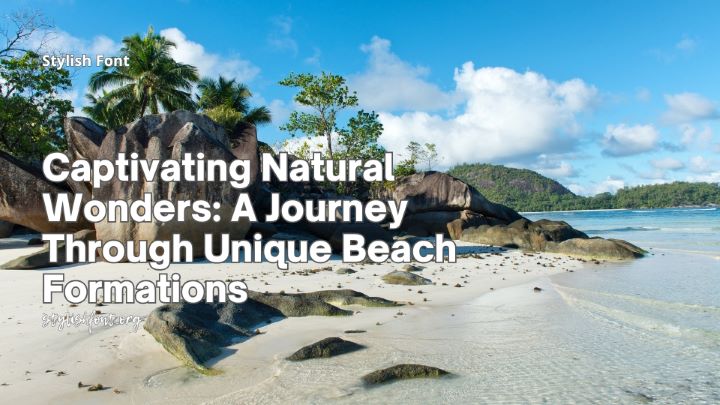Key Takeaways
- Discover the enchanting beauty of diverse beach landscapes.
- Learn about the science and geology behind unique beach formations, such as black sand and glass beaches.
- Gain insights into how these natural wonders are formed and where they can be found globally.
- Understand the environmental significance of these beaches.
Introduction
Beaches are among our planet’s most cherished natural landscapes, serving as serene getaways where the sea meets the shore in a harmonious dance of natural beauty. They offer relaxation and an opportunity to connect with the natural world. While typical sandy shores are beautiful, some unique beaches stand out due to their unusual sand colors and fascinating geological histories. This article will explore some of the most intriguing beach formations. These remarkable natural wonders invite us to delve deeper into the world of geology and environmental science to understand their origins and significance.
The Formation of Unique Beach Sand Colors
The formation of unique beach sand colors is a fascinating process shaped by geological factors and environmental conditions. While many beaches boast golden or white sand, others stand out with hues like black sand, such as the renowned black sand beach in Iceland. These distinct colors often result from specific minerals or volcanic activity. In the case of black sand beaches, volcanic eruptions pulverize lava rocks into fine particles, creating striking dark sands that contrast beautifully with the surrounding landscape. Understanding the formation of these unique beach sands adds to the allure of coastal exploration and deepens our appreciation for the Earth’s natural wonders.
The Allure of Black Sand Beaches
Black sand beaches are a striking anomaly in the beach world, instantly recognizable by their dramatic dark hues. These can be found in volcanic regions worldwide. The distinct color of black sand beaches is derived from volcanic minerals and lava fragments. When molten lava meets cold ocean water, it cools rapidly and shatters into fine particles of basalt and other dark-colored minerals. Over time, these particles accumulate along the shoreline, creating the stunning black sands we see today. These beaches provide a unique visual experience and offer a glimpse into the dynamic volcanic activity that shapes these landscapes. Walking along a black sand beach is like stepping onto another planet, with the dark sand contrasting sharply against the blue ocean, creating an otherworldly beauty.
Unveiling the Beauty of Glass Beaches
Unveiling the beauty of glass beaches reveals nature’s remarkable ability to transform discarded materials into stunning works of art. These unique coastal formations result from years of natural processes shaping glass bottles and other debris into smooth, colorful gems. Over time, the relentless action of waves and tides grinds down these once-unsightly objects, polishing them into dazzling treasures that sparkle in the sunlight. Discovering glass beaches is a moving way to remember the value of environmental preservation and ethical waste management, as well as a window into the tenacity of the natural world.
The Stunning Pink Sand Beaches
Pink sand beaches are among the rarest and most visually striking coastal features, characterized by blush-colored sands. The unique pink hue is attributed to tiny red marine organisms known as foraminifera. These single-celled creatures possess reddish shells that, upon their demise, mix with the white calcareous sand from broken corals and shells to create the pink coloration. The gentle interplay of these pink-tinged grains with the shoreline creates a romantic and dreamy landscape that’s hard to forget. The aesthetic allure of pink sand beaches has made them a favorite among photographers and couples seeking picturesque getaway locations, showcasing the fascinating ways nature combines different elements to produce beautiful results.
Environmental Significance and Conservation
While the visually stunning nature of these unique beaches captivates our senses, it’s essential to recognize their ecological importance and vulnerability. In addition to serving as natural barriers that shield coastlines from erosion and storm damage, beaches are necessary for providing a home for various marine and terrestrial creatures. Black, glass, and pink sand beaches each have environmental challenges. For example, black sand beaches face threats from mining activities looking to extract precious minerals. Glass beaches may be under threat from well-meaning but misguided visitors who take pieces of sea glass as souvenirs. Rising sea levels and climate change could adversely affect pink sand beaches, threatening the delicate balance of marine life that contributes to the unique sand compositions. Conservation efforts are essential to safeguard these natural wonders. This entails defending the natural environment and spreading awareness among the populace of the value of preserving these distinctive landscapes for coming generations.
Conclusion
Unique beach formations such as black sand beaches, glass beaches, and pink sand beaches do more than appeal to the eye; they offer deep insights into the geological and environmental processes at play in our world. As we enjoy the splendor of these natural wonders, it’s vital to support conservation efforts to ensure that these remarkable sites remain untouched by the adverse effects of human activity. The next time you set foot on one of these extraordinary beaches, take a moment to appreciate the intricate natural processes that have crafted these breathtaking landscapes over millennia. Every distinct beach has a tale to tell, and by protecting these natural treasures, we ensure that these tales will continue to enlighten and inspire upcoming generations.





